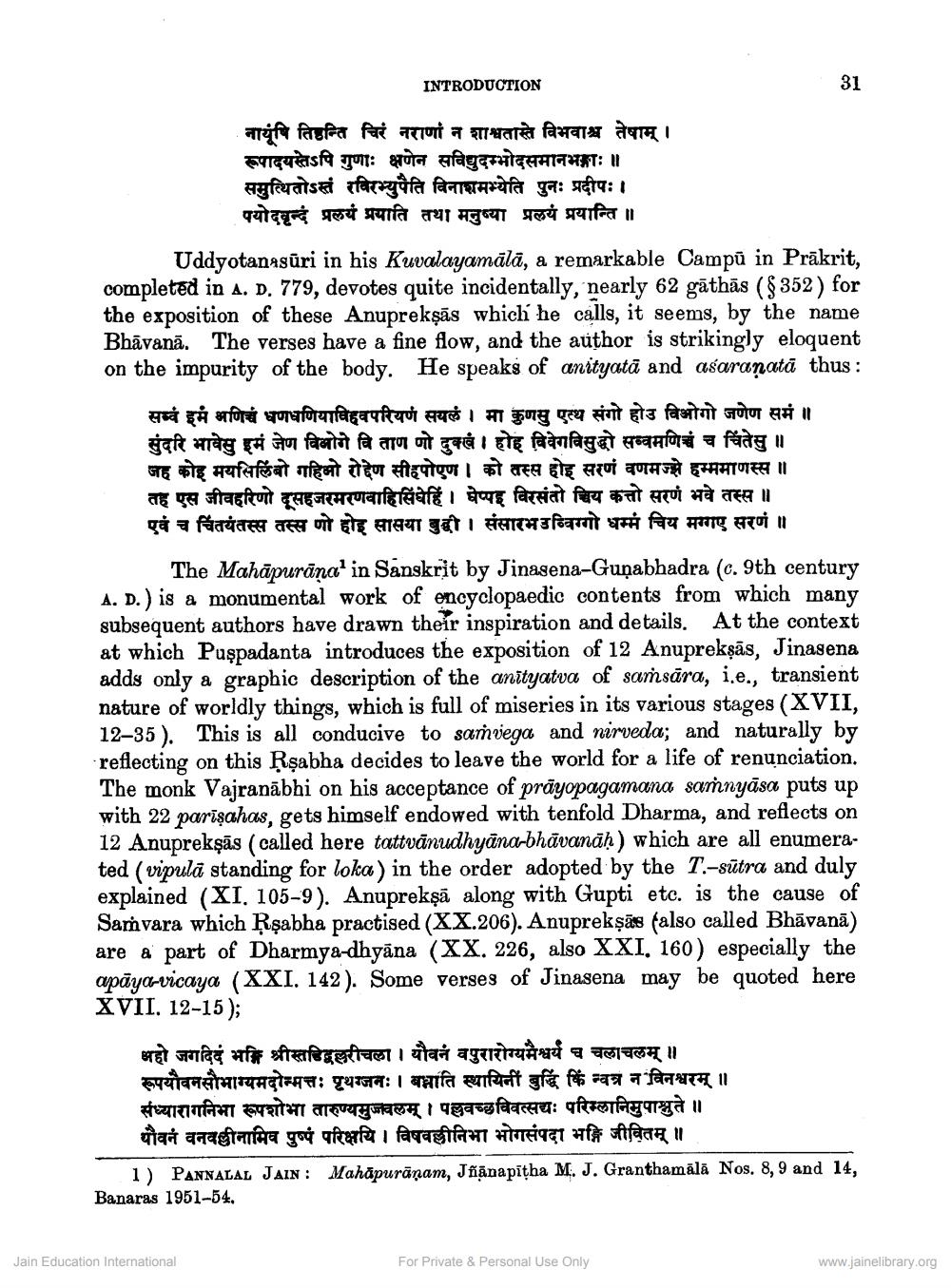________________
INTRODUCTION
नायूंषि तिहन्ति चिरं नराणां न शाश्वतास्ते विभवाश्च तेषाम् । रूपादयस्तऽपि गुणाः क्षणेन सविधुदम्भोदसमानभाः ॥ समुत्थितोऽस्तं रविरभ्युपैति विनाशमभ्येति पुनः प्रदीपः। पयोदवृन्दं प्रलयं प्रयाति तथा मनुष्या प्रलयं प्रयान्ति ॥
Uddyotan guri in his Kuvalayamālā, a remarkable Campū in Prākrit, completed in a. D. 779, devotes quite incidentally, nearly 62 gāthās ($352) for the exposition of these Anuprekşās which he calls, it seems, by the name Bhāvanā. The verses have a fine flow, and the author is strikingly eloquent on the impurity of the body. He speaks of anityatā and asaranatá thus :
सम्वं इमं अणि धणधणियाविहवपरियणं सयलं । मा कुणसु एस्थ संगो होउ विओगो जणेण समं ॥ सुंदरि भावेसु इमं जेण विनोगे वि ताण णो दुक्खं । होह विवेगविसुद्धो सम्वमणिचं च चिंतेसु ॥ जह कोइ मयसिलिंबो गहिओ रोईण सीहपोएण। को तस्स होइ सरणं वणमझे हम्ममाणस्स ॥ तह एस जीवहरिणो दूसहजरमरणवाहिसिंघेहिं । घेप्पह विरसंतो चिय कत्तो सरणं भवे तस्स ॥ एवं च चिंतयंतस्स तस्स णो होइ सासया बुद्धी । संसारभउग्विग्गो धम्म चिय मग्गए सरणं ॥
The Mahāpurāna' in Sanskrit by Jinasena-Guņabhadra (c. 9th century A. D.) is a monumental work of encyclopaedic contents from which many subsequent authors have drawn their inspiration and details. At the context at which Puşpadanta introduces the exposition of 12 Anuprekşās, Jinasena adds only a graphic description of the anītyatva of saṁsāra, i.e., transient nature of worldly things, which is full of miseries in its various stages (XVII, 12–35 ). This is all conducive to samvega and nirveda; and naturally by reflecting on this Rşabha decides to leave the world for a life of renunciation. The monk Vajranābhi on his acceptance of prayopagamana sarnnyāsa puts up with 22parisahas, gets himself endowed with tenfold Dharma, and reflects on 12 Anupreksas (called here tattvānudhyāna-bhāvanāh) which are all enumerated (vipulā standing for loka) in the order adopted by the T.-sūtra and duly explained (XI. 105-9). Anuprekşā along with Gupti etc. is the cause of Samvara which Rşabha practised (XX. 206). Anuprekşās (also called Bhāvanā) are a part of Dharmya-dhyāna (XX. 226, also XXI. 160) especially the apāya-vicaya (XXI. 142). Some verses of Jinasena may be quoted here XVII. 12-15);
अहो जगदिदं भङ्गि श्रीस्तडिद्वल्लरीचला । यौवनं वपुरारोग्यमैश्वर्य च चलाचलम् ॥ रूपयौवनसौभाग्यमदोन्मत्तः पृथग्जनः । बध्नाति स्थायिनी बुद्धिं किं न्वत्र न विनश्वरम् ॥ संध्यारागनिभा रूपशोभा तारुण्यमुजवलम् । पल्लवच्छविवत्सद्यः परिम्लानिमुपाश्नुते ॥ पौवनं वनवल्लीनामिव पुष्पं परिक्षयि । विषवल्लीनिभा भोगसंपदा भङ्गि जीवितम् ॥
1) PANNALAL JAIN: Mahăpuräņam, Jñanapītha M. J. Granthamālā Nos. 8, 9 and 14, Banaras 1951-54.
Jain Education International
For Private & Personal Use Only
www.jainelibrary.org




